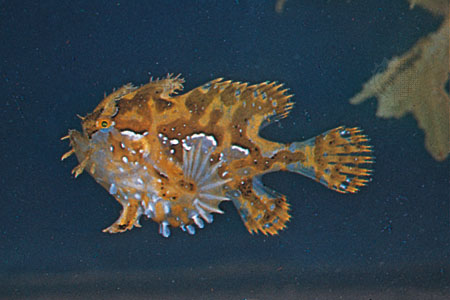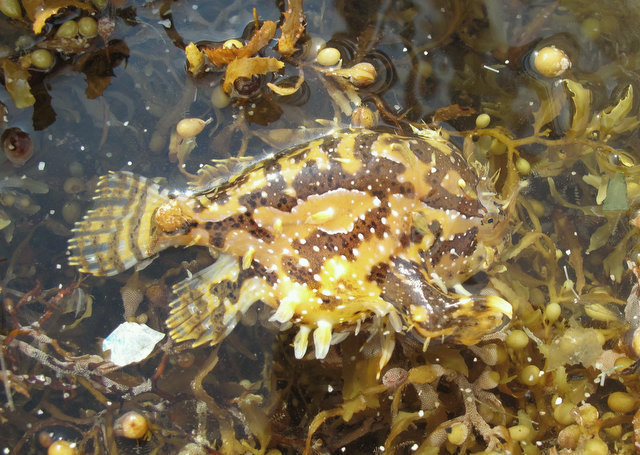
Histrio histrio
FAMILY
Antennariidae
TAXONOMY
Histrio histrio (Linnaeus, 1758).
OTHER COMMON NAMES
English: Sea mouse, mousefish.
PHYSICAL CHARACTERISTICS
Frogfishes (
FAMILY
Antennariidae) are somewhat similar to their
monkfish relatives in that they have a large head on which are
located several isolated dorsal fin spines; the pectoral fins appear
armlike. They are strikingly different in that the head is
globose and the body is flattened laterally (compressed) rather
than dorsally (depressed). In addition, the second and third
dorsal fin spines usually are surrounded by so much fleshy skin
that it may be difficult to recognize them as fin spines. The
second, or soft, dorsal and anal fins are much more conspicuous,
and the soft dorsal is usually much longer than the anal
fin. The sargassumfish is characterized by its very short angling
apparatus and its smooth skin, which lacks the small, spiny
scales or dermal spinules typical of most other frogfishes. Its
color pattern is changeable and highly variable, but it is usually
cryptic, consisting of streaks, spots, and mottling of brown,
olive, and yellow, making it nearly impossible to detect among
the sargassum weed in which it hides.
DISTRIBUTION
The sargassumfish has the widest geographic
DISTRIBUTION
of any
frogfish. Being an obligate associate of sargassum weed, they are
found wherever this species occurs, that is, in tropical, warm
temperate, and occasionally cool temperate waters of the Atlantic,
Pacific, and Indian Oceans. They appear to be very rare in the
eastern Atlantic, and they are absent from the eastern Pacific.
HABITAT
The sargassumfish is the only frogfish species that is not benthic.
It is only found associated with the epipelagic brown algae,
Sargassum, in tropical and warm temperate environments.
Although Sargassum is usually pelagic, members of the community
associated with it, including the sargassumfish, are technically
pseudopelagic.
BEHAVIOR
Most of what is known about the
BEHAVIOR
of sargassumfish is
associated with their feeding. This
BEHAVIOR
is described in the
introductory section.
FEEDING ECOLOGY AND DIET
Like most other anglerfishes, sargassumfish are ambush predators
that use aggressive mimicry to attract prey. Most observers
describe them as particularly voracious, feeding readily and indiscriminately
on anything they can swallow, including fishes
as long as or longer than themselves. They even consume
other sargassumfish. They are one of the major predators of
the sargassum community.
REPRODUCTIVE BIOLOGY
Reproduction in the sargassumfish is similar to the known reproductive
BEHAVIOR
of other anglerfishes. The eggs are released
in the typical egg veil or raft, which in sargassumfish
may be 35–47 in (90–120 cm) long and 2–4 in (5–10 cm) wide.
CONSERVATION STATUS
Not threatened.
SIGNIFICANCE TO HUMANS
None known.
Photo Gallery of - Sargassumfish





 Animalia Life
Animalia Life